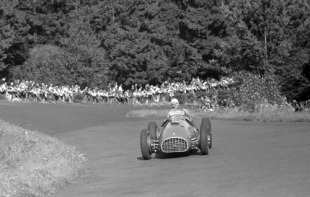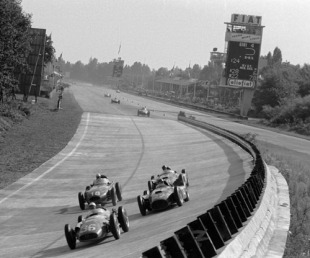- Top Tens - Old circuits
The good, the bad and the dangerous
Laurence Edmondson and Martin Williamson May 10, 2010We look at ten grand prix circuits which are no longer with us or which are a shadow of their former selves

Twisting around the remains of an extinct volcano, Clermont Ferrand is sometimes described as a shorter, faster and tighter version of the Nurburgring. At 5 miles it was about a third of the length of the 'ring, but provided as much excitement as drivers negotiated a relentless stream of corners with no discernable straights. It hosted just four grands prix (1965, 1969, 1970, 1972) but left a very lasting impression on those who drove it. A number of participants in the 1969 event insisted on driving with open-faced helmets in case of motion sickness. Loose stones at the final grand prix in 1972 caused ten punctures and ended Helmut Marko's career when one flew up from Emerson Fittipaldi's rear tyre and partially blinded him. Concerns over the lack of run-off led to a re-profiling of the circuit in 1988, shortening it to 2.4 miles.
Old Interlagos, Brazil
The old version of the Brazilian circuit incorporated most of the tight and twisty infield still present today, along with a balls-out, high-speed section. The original layout consisted of four fast corners, split up by long straights, in which the cars would remain flat out for around 20 seconds. With significant bumps throughout the lap, the track was considered very dangerous - especially by 1980 when cars were running ground-effect aerodynamics. That, and the encroaching favellas around the circuit, saw the Brazilian Grand Prix move to the more glamorous Jacarepagua circuit in Rio de Janeiro. When it returned in 1990 a $15 million redevelopment plan had stunted the circuit to today's layout.
Osterreichring, Austria
Set into an Austrian hillside, the Osterreichring has gone down in F1 folklore as one of the sport's most exciting circuits. Dramatic elevation changes and super-fast sweeping curves made it a real drivers' circuit and the small run-off areas and ludicrously-narrow pit straight made it exceptionally dangerous. Most dangerous of all was the 180 degree Boschkurve, where close barriers all the way around the outside loomed ominously to punish the slightest mistake, hard. Despite the safety concern, which contributed to F1 abandoning the circuit after 1987, the only F1 death was in 1975 when Mark Donohue crashed during practice. In 1995 F1 returned to the venue, then known as the A1 Ring, but the race took place on a completely rebuilt and neutered version of the track designed by Hermann Tilke.
Bremgarten, Switzerland
Five Formula One grands prix were held at Bremgarten up until motorsport was banned by the Swiss in 1955, following the Mercedes tragedy at Le Mans. But the authorities could have made a case for the ban based on its own circuit, which claimed the life of Hugh Hamilton at its very first race in 1934. The tree-lined circuit had no obvious straight, and in the wet the narrow strip of tarmac (originally designed for motorbikes) was particularly treacherous. Once the ban was enforced Bremgarten fell into disrepair and was finally lost forever under the urban sprawl of nearby Bern.
Pescara, Italy
The longest and probably most dangerous circuit in Formula One history held just one championship grand prix in 1957. The layout consisted of two long straights joining the towns of Capelle, Monte Silvano and Pescara as well as a wild ride through the Abruzzo hills, a mile of which was on cliff-top roads with 500 foot drops to one side. The circuit was first used in 1924 and hosted regular non-championship races until it was closed in the 1960s due to safety concerns. Stirling Moss won the 1957 event driving a Vanwall in front of 200,000 spectators, after Ferrari decided not to participate in protest to the Italian government's proposal to ban road racing. Describing the circuit 40 years later in Richard Williams' The Last Road Race, Moss said of Pescara: "I thought it was fantastic. It was just like being a kid out for a burn-up. A wonderful feeling. What racing's all about."

The modern circuit, built in the 1980s, is a shadow of the 1920s beast that went before. Opened in 1925, the original North Loop track was 17½ miles long, no more than 30 feet wide, with 174 turns and an undulating surface. Even in those less safety-conscious times, it was deemed too dangerous and by the late 1930s the shorter 14.17-mile Nordschliefe was in use. To add to the challenge, the location was prone to rain and fog, even in the summer, and its length meant conditions could vary even on a single lap. Many top drivers never really mastered the course and it was growing concerns over safety that led to major changes in 1970, but by the time it staged its last grand prix in 1976 - remembered for the horrific accident which almost killed Niki Lauda - it had become an anachronism.
Brooklands, England
The world's first purpose-built race track was constructed after road racing started to fall foul of the authorities in Europe after a string of fatalities. Opened in 1907, the distinctive banked, oval track, which was nearly 30 feet high in places, was finished in concrete because of the issues of laying tarmac on such a gradient. Along the centre of the track ran a dotted black line, known as the Fifty Foot Line. By driving over the line, a driver could theoretically take the banked corners without having to use the steering wheel. In 1926 the track hosted the first British Grand Prix, and regular racing continued right up to the war, along with other events, including massed cycling. In 1939 racing was stopped and the site became a hub for the production of military aircraft, leading to large areas of the track being destroyed to build factories. When the war ended there was no way racing could resume and the land was sold to Vickers-Armstrong where it continued through various identities until it was sold in 1988 for redevelopment.
Mosport, Canada
Autumn - fall in North America - used to mean a double-header of the United States and Canadian Grands Prix, both held on circuits surrounded by trees with their leaves in flaming colour. This was when Canada used Mosport Park, a magnificent road course in Eastern Ontario that ran through wooded countryside but as safety became more of an issue it was increasingly regarded as dangerous and its facilities outdated. The lack of run-off became a major factor in the Grand Prix's move to Montreal in 1978. Sports car impresario Don Panoz bought the failing track in 1998 and has since modernised it.

Belgium's Spa Francorchamps circuit is one of the oldest on the current F1 calendar, hosting its first race in 1922 and its first grand prix in 1925. The original circuit made up of narrow roads was 9.3miles long (14.9km) and was notoriously dangerous. It was a fast course and until 2000 it was possible to travel over the track as it was a public road. Its speed meant Spa had a poor safety record. At the 1960 grand prix Chris Bristow and Alan Stacey were killed within minutes of each other, and in 1966 Jackie Stewart crashed and found himself upside down in the cellar of a farmhouse with petrol pouring over him. The old track hosted its final race in 1970, when it was deemed too dangerous for F1; a year earlier drivers had boycotted the race. When it returned in 1983 it had been shortened and sanitised.
Old Monza, Italy
Few names are as evocative as Monza, built in 1922 and for many years one of the fastest circuits. It was the first purpose-built venue to stage a grand prix and the first to charge for entry. It was also two tracks. One, a US-style oval with two straights and two heavily-banked corners (demolished in 1938) the other a facsimile of a road circuit. But while hugely popular, it was also highly dangerous. In 1928 a driver and 27 spectators were killed, and despite safety modifications, five years later three top drivers died in one race. A new banked circuit was built in 1955 but this only staged two grands prix before being ditched because of concerns over the stresses it imposed on cars. But even the road course was unsafe, and in 1961 Wolfgang von Trips died along with 14 spectators when he crashed. The current track is slower and safer.
Martin Williamson is managing editor of digital media ESPN EMEA
© ESPN Sports Media Ltd.
 Martin Williamson is managing editor of digital media ESPN EMEA Martin Williamson, who grew up in the era of James Hunt, Niki Lauda and sideburns, became managing editor of ESPN EMEA Digital Group in 2007 after spells with Sky Sports, Sportal and Cricinfo
Martin Williamson is managing editor of digital media ESPN EMEA Martin Williamson, who grew up in the era of James Hunt, Niki Lauda and sideburns, became managing editor of ESPN EMEA Digital Group in 2007 after spells with Sky Sports, Sportal and Cricinfo

